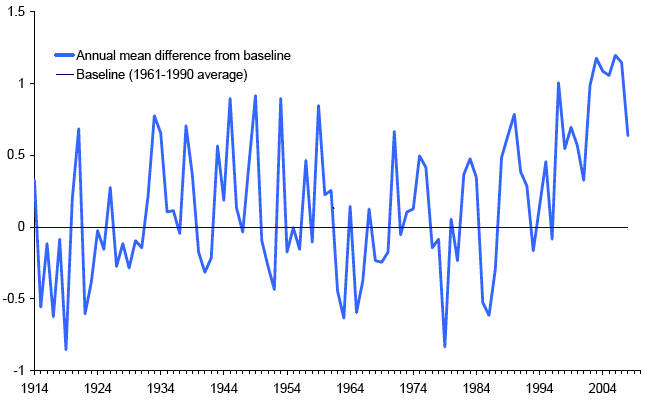Key Scottish Environment Statistics 2009
Annual publication containing summary of key statistics on environmental trends in Scotland
Global Atmosphere
Annual Mean Temperature R: 1914-2008
Annual mean temperature - difference from 1961-1990 average 1 (degrees Celcius)

1910s 2 |
1920s |
1930s |
1940s |
1950s |
|
Difference from 1961-1990 baseline 1(°C) |
-0.32 |
-0.07 |
0.27 |
0.24 |
0.10 |
1960s |
1970s |
1980s |
1990s |
2000s 2 |
|
Difference from 1961-1990 baseline 1(°C) |
-0.18 |
0.05 |
0.07 |
0.41 |
0.91 |
The balance between incoming solar energy and outgoing infrared radiation determines the earth's temperature. Changes in the amount of energy retained within the atmosphere affects global climate, which naturally exhibits long-term fluctuations. Current climate trends are unlikely to be entirely natural in origin however, and there is now evidence that human activities are having a discernible impact on the global climate. 3
Whilst the global impacts of climate change are considerable, there are also wide-ranging implications for Scotland. Flood risk, water resources, agriculture, tourism and health may be affected, all of economic, social and environmental importance.
Over the period 1901-2000, the change in mean global surface temperature explained by a linear trend is 0.57 degrees Celsius (°C). 4 Similarly, a linear trend through the Scottish temperature series for the period 1914-2008 indicates an average annual increase of 0.007°C, or 0.7°C each 100 years. The temperatures between 2003 and 2007 in Scotland were the highest since the record began in 1914. The average annual temperature recorded in 2008 was over 0.5°C lower than in 2007 but remained in the upper quintile of temperatures recorded since 1914.
By 2080, temperatures in Scotland are predicted to rise by around 3.5°C during the summer months and around 2.6°C during the winter months. 5
Source: Met Office
There is a problem
Thanks for your feedback